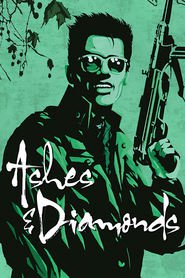
Andrzej Wajda’s, “Ashes and Diamonds” asks the question on what has happened to Post War Poland. Has the heat of the destructive Nazi occupation resulted in a country of ashes or have the communists formed a diamond. At the end of the film we are well aware of how Wajda saw the answer to that question.
The film revolves around a 24 hour period in a small and nameless Polish town on the day that the Nazi’s surrendered (May 8, 1945). That day starts as a beautiful sunny spring day in the country where we meet three protagonists lazing on the grass and seemingly enjoying the moment. Wajda’s camera immediately lets us know that we have been fooled as all three are awakened by an oncoming car for which they take out their machine guns and kill its two occupants in cold blood. This initial scene of violence stands out for its realistic grittiness that was shocking for audiences in 1958. We are treated to grimaced stares of terror and close up death. The killers are machine-like in their brutality and the bullets tear flesh and cause clothes to catch fire. The camera sets its focus on the pain and force of the killings. It is a style that would be copied later in celebrated films by Friedkin, Scorsese, Coppola and others.
The killers are Polish Underground home army soldiers who are ordered to kill the new regional soviet party secretary (Szcuzuka). Their victims however were not Szcuzuka and his staff but innocent Polish citizens from the nearby town. One of the killers is the foot soldier Maciek (Zbigniew Cybulski is a powerhouse performance worthy of world acclaim). Cybulski plays Maciek with his constant dark sunglasses like a vicious James Dean with a temperament and encompassing acting style that reminded me of a young Brando.
Maciek and his cohorts enter the adjacent town and in the local hotel realize their terrible mistake. Szcuzuka (Waclaw Zastrzezynski playing him as a thoughtful and brooding leader) has also arrived at this hotel and Maciek is ordered to complete his failed mission. While biding his time over night at the hotel (renting a room above his intended victim), Maciek is attracted to the local bar-tending beauty. It is this attraction that makes him realize the potential of living in peace. This is a man who spent all of his adult life as an active participant in war. Love and peace are foreign to him and he wants to find out what they feel like. He still has his orders and is still a soldier. There lies the great dilemma of the film.
The movie was made with deep focus photography that allowed Wajda to visualize all of the conflicting turmoil that was occurring in his home country at that historic date. He packs his film with stunning scenes of visual splendor throughout. One scene has an inverted crucifix in a rubble-strewn church while another has a spectacular rider-less white horse all of which visualize the damaged psyche of Poland and its occupation. A brutal violent scene is illuminated by fireworks celebrating the end of the war and the shot of blood-soaked linen evokes the shattered Polish national flag.
By placing his hero as an anti-communist nationalist Wajda risked the fury of the soviet era sensors, which is probably the reason that the communist characters come off as intelligent and sympathetic. The film gives very clear references to the similarities of the two sides and their shared history, fighting the Nazis.
This is an intelligent and riveting film from behind the iron curtain that uses various western influences to tell its very personal tale. It has an ending that lingers long after the closing credits and is rightfully lauded as one of world cinemas great films. Not to be missed.

